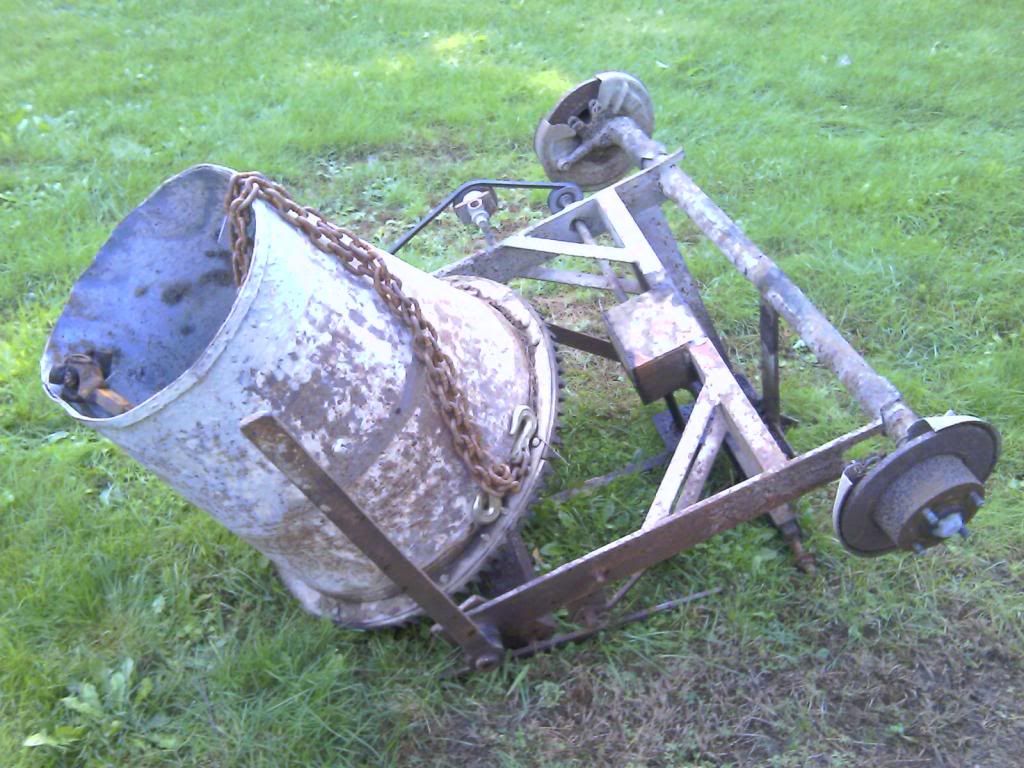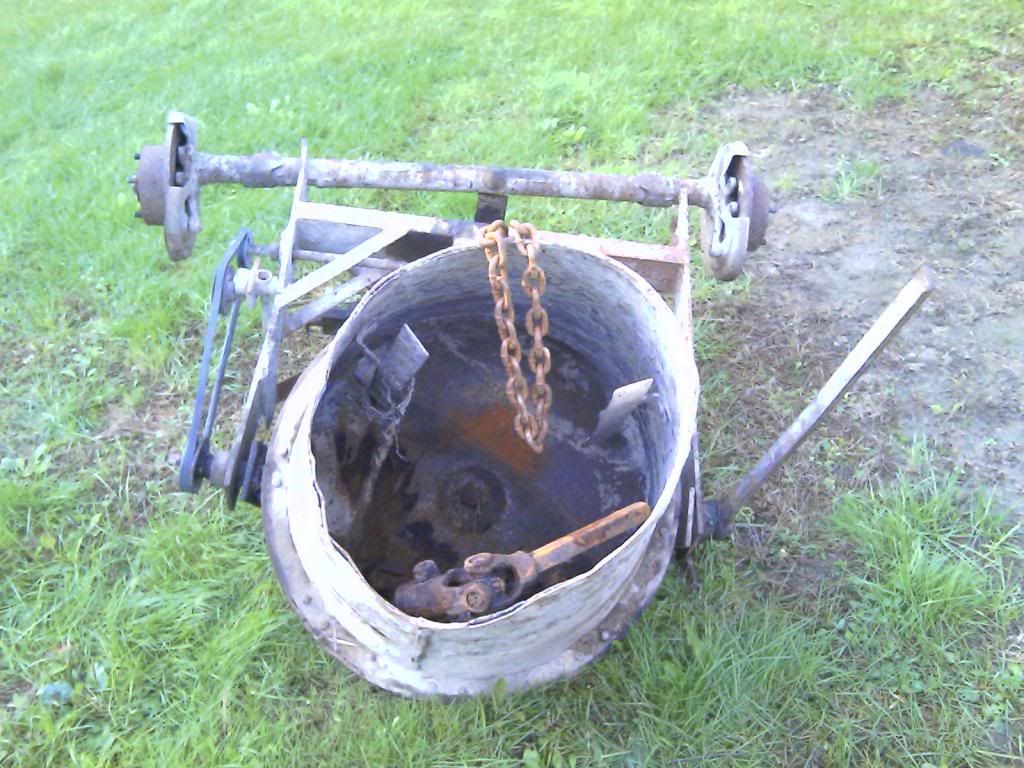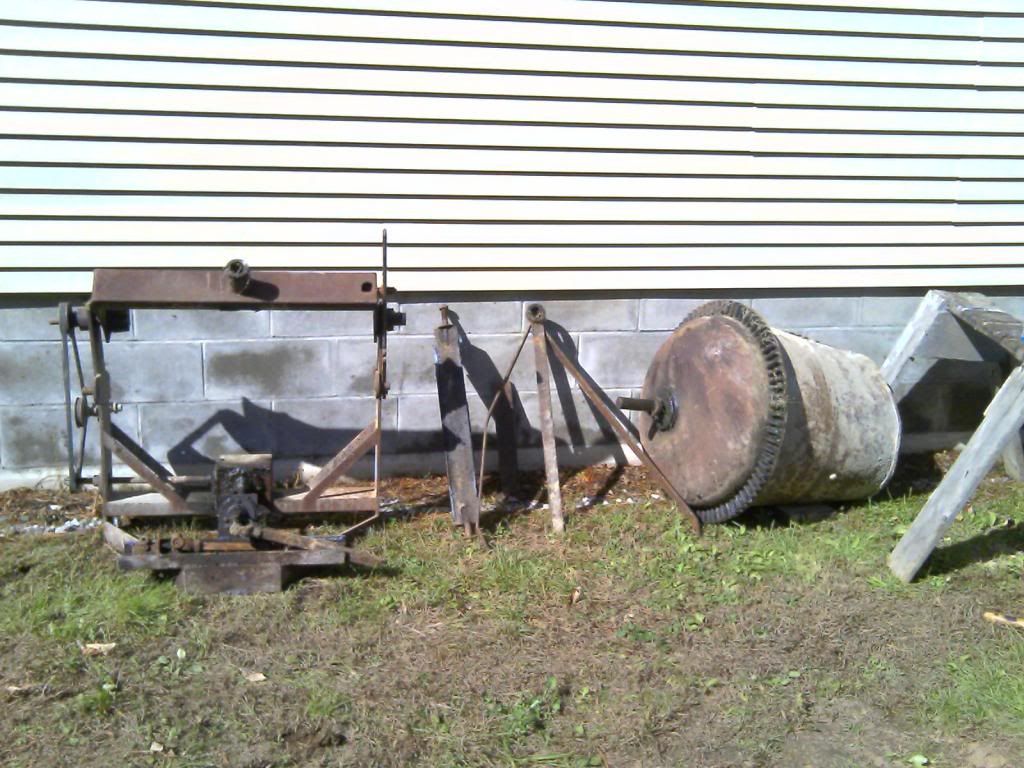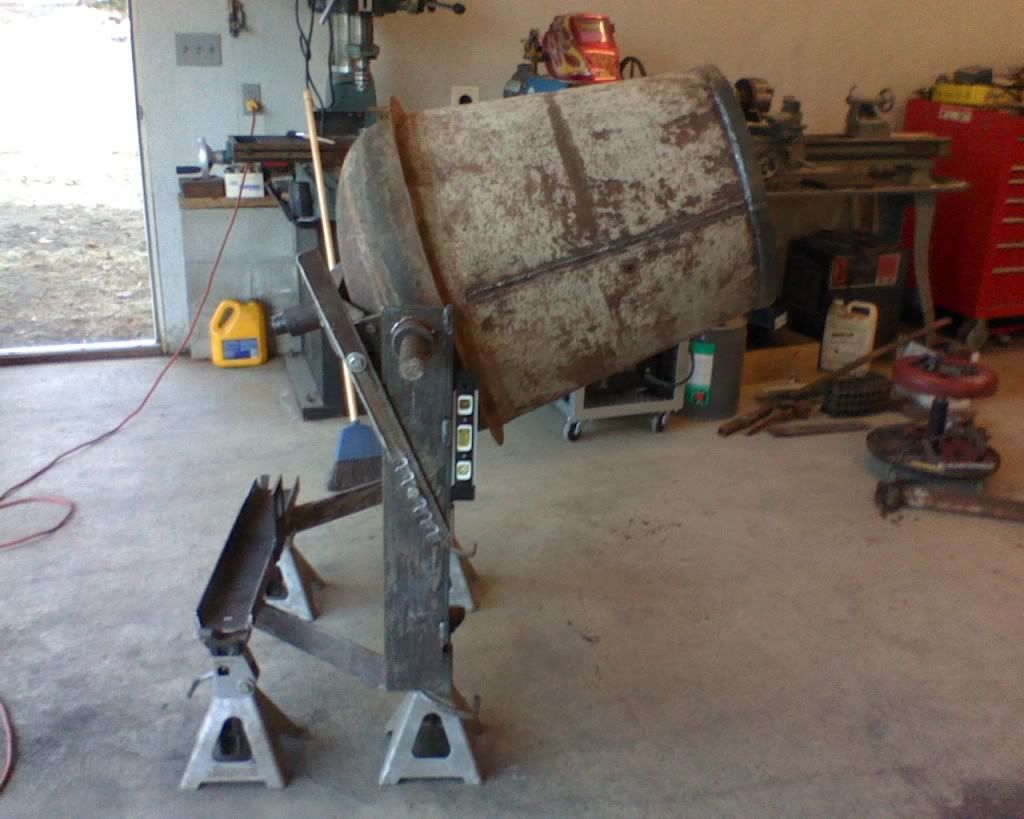This isn't a true built-it-yourself, but since every piece of it needs to be reworked to some extent, it's pretty much like building it from scratch. Last fall I dragged this battered cement mixer home - it was scheduled for a date with the scrapyard if I hadn't intervened:


For additional reference, the drum measures about 24 inches at the widest point, 18 inches at the opening, and 30 inches long.

The best I can tell it was always PTO powered, but I think it has been used as both towed and 3 point hitch. The axle it a retrofit, and the 7/8 bolts welded on for 3 point lift are obviously not original, so I have no clue how this started out life. I am going going to put it back to life as a 3 point hitch implement, but since it has been hacked apart and cobbled together, it's hard to tell exactly how it should be set up. I need help with the following things:
1. What is the height of the average mixer at the bottom of the drum, when set for mixing? In the following picture I have it tentatively set at what I think might be a good height. Assuming that the angle I have it set at is reasonable for mixing, would 33+ inches from the floor to the bottom of the drum be a good height to shovel into? For those of you with mixers, what is the height you have to shovel to? I need it to be as high as is reasonable so that when it dumps you can get a wheelbarrow under it.
2. What is an acceptable rotational speed for the drum on a mixer? I don't trust any of the pulley sizes to be correct, so I want to start with the drum speed and work backwards. What I know to start with is that I have an 81:8 ratio on the ring gear and a 1:1 ratio on the gearbox, so I have to size the pulleys to get the final speed from the PTO reduced. I'm thinking drum speed should be around 50 RPM? This question leads me to my final question - for now...
3. Is a tractor's PTO speed linear? What I mean is that my tractor is rated for 540 PTO RPM at 2600 engine RPM. Does this mean that at idle (800 RPM) the PTO speed would be about 166 RPM? I'm hoping I can run the tractor at about idle, since it shouldn't take too much effort to spin a mixer drum. I'm going to be using this with a John Deere 770 which is a 1.4 liter diesel with around 24 engine HP and 20 HP at the PTO. Do you think i can do this at idle, and will my PTO speed be what I think it will be?
Here's where it sits right now:

The sheet metal seam on the drum has been cut out and welded since it had been partially separated. The drum has been straightened and a new and heavier ring has been welded on to reinforce the opening.
The entire frame has been adjusted (bad welds and poor alignment corrected as well as possible). The vertical supports have been reinforced to limit flexing.
The yoke has been cut and welded up so that it matches the contour of the drum as opposed to being straight. The original yoke had long ears on it that had flexed and bent at some point. the contoured yoke has less free length to bend. The original also appeared to have been built in place. there was no way to take the unit apart without cutting it. There are now bolts holding the ears to the yoke to allow removal.
The next step is to figure the height I need for everything and then build skids and legs for the unit to rest on.


For additional reference, the drum measures about 24 inches at the widest point, 18 inches at the opening, and 30 inches long.

The best I can tell it was always PTO powered, but I think it has been used as both towed and 3 point hitch. The axle it a retrofit, and the 7/8 bolts welded on for 3 point lift are obviously not original, so I have no clue how this started out life. I am going going to put it back to life as a 3 point hitch implement, but since it has been hacked apart and cobbled together, it's hard to tell exactly how it should be set up. I need help with the following things:
1. What is the height of the average mixer at the bottom of the drum, when set for mixing? In the following picture I have it tentatively set at what I think might be a good height. Assuming that the angle I have it set at is reasonable for mixing, would 33+ inches from the floor to the bottom of the drum be a good height to shovel into? For those of you with mixers, what is the height you have to shovel to? I need it to be as high as is reasonable so that when it dumps you can get a wheelbarrow under it.
2. What is an acceptable rotational speed for the drum on a mixer? I don't trust any of the pulley sizes to be correct, so I want to start with the drum speed and work backwards. What I know to start with is that I have an 81:8 ratio on the ring gear and a 1:1 ratio on the gearbox, so I have to size the pulleys to get the final speed from the PTO reduced. I'm thinking drum speed should be around 50 RPM? This question leads me to my final question - for now...
3. Is a tractor's PTO speed linear? What I mean is that my tractor is rated for 540 PTO RPM at 2600 engine RPM. Does this mean that at idle (800 RPM) the PTO speed would be about 166 RPM? I'm hoping I can run the tractor at about idle, since it shouldn't take too much effort to spin a mixer drum. I'm going to be using this with a John Deere 770 which is a 1.4 liter diesel with around 24 engine HP and 20 HP at the PTO. Do you think i can do this at idle, and will my PTO speed be what I think it will be?
Here's where it sits right now:

The sheet metal seam on the drum has been cut out and welded since it had been partially separated. The drum has been straightened and a new and heavier ring has been welded on to reinforce the opening.
The entire frame has been adjusted (bad welds and poor alignment corrected as well as possible). The vertical supports have been reinforced to limit flexing.
The yoke has been cut and welded up so that it matches the contour of the drum as opposed to being straight. The original yoke had long ears on it that had flexed and bent at some point. the contoured yoke has less free length to bend. The original also appeared to have been built in place. there was no way to take the unit apart without cutting it. There are now bolts holding the ears to the yoke to allow removal.
The next step is to figure the height I need for everything and then build skids and legs for the unit to rest on.
